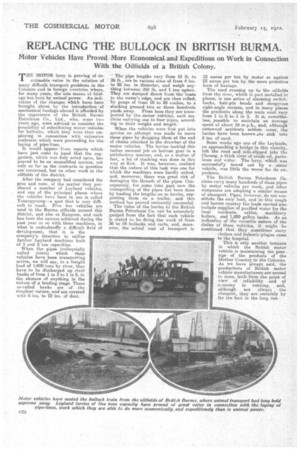REPLACING THE BULLOCK IN BRITISH BURMA.
Page 26

If you've noticed an error in this article please click here to report it so we can fix it.
Motor Vehicles Have Proved More Economical and Expeditious on Work in Connection With the Oilfields of a British Colony.
rr HE MOTOR lorry is proving of in estimable value in the solution of many difficult transport problems in the Colonies and in foreign countries where, for manyyears, the sole means of
haulage has been by animal power. An indication of the changes whkh have been brought about by the introduction of mechanical haulage abroad is afforded-by the -experience of the British .Burma Petroleum Co., Ltd., who, some two years ago, were advised to consider the possibility of substituting motor vehicles for bullocks, which they were then employing in connection with extensive contracts which were proceeding for the. laying of pipe-lines.
It would appear from reports which have just come to hand that the suggestion, which was duly aeted upon, has proved to be an unqualified success, not only se far as the contracts in question are concerned, but on other work in the oilfields of the district.
After the company had considered the pros and cons, of the matter they purchased a number of Leyland vehicles, and one of the principal places where the vehicles have been in use is called Yenangyoung—a spot that is very difficult to reach. Five ton vehicles are used in the Burma oilfields around this district, and also at Rangoon, and such has been the success achieved during the past year or so with these machines, in what is undoubtedly a difficult field of development, that it is the company's intention to utilize further Leyland machines both of 3 and 5 ton capacities.
'When the. pipes. (colloquially called joints) which thee vehicles have been transporting arrive, we will say, in a freight load of 1a000 tons by river, they have to be discharged up river banks of from 1 in 3 to 1 in 5, in the absence of anything in the nature of a landing 'stage. These so-called banks are of the roughest nature, and are covered with 6 ins. to 12 ins, of dust. The, pipe lengths vary flora 18 ft. to 26 ft., are in various sizes Of from 4 ins. to 22 ins, in diameter, and weigh anything between 200 lb. and 1. ton apiece. They are damped direct from the boats to the water's edge, and are then rolled; by gangs of from 50 to 80 coolies, to a stacking ground two or three hundreds yards away. From here they are transported by the .motor vehicles, each machine carrying one to four pipes, according to their weight. and length:
When the vehicles were first put into service an attempt was made to move these pipes by dragging them at the end of chains attached to the drawbar of the motor vehicles. The lorries tackled this rather unusual job on bottom gear in a satisfactory manner, and, as a matter of fact, a lot of stacking was done in this way at first. It was, however, realized that the nature of this task was one for which the machines were hardly suited,' and, moreover, there was great risk of damaging the threads of the pipes. Consequently, for some time past now the transporting of the pipes has been done by loading the lengths on to lorries, supporting them on a trailer, and. this method has proved eminently successful.
The value of the lorries to the British Burma Petroleum Co. can be accurately gauged from the fact that each vehicle is stated to be doing the work of from 36 to 54: bullocks and carts, and, moreover, the actual cost of transport is 12 aunas per ton by motor as against 22 annas per ton by the more primitive form of haulage.
The road running up to the oilfields from the river, which is part metalled in places, is one series of alarming switchbacks, hair-pin bends and dangerous right-angle corners, and in many places the gradients along the main road vary from 1 in 8 to 1 in 3. It is, nevertheless, possible to maintain an average speed of about 10m ph., and, although untoward accidents seldom occur, the lorries have been known arta sink into 8 ins, of sand.
Some weeks age one of the Leylands, on approaching a bridge in this vicinity, left the road and .side-slipped into the Choung, a thick river of crude oil, petroleum and water. The lorry, which was successfuPy towed out by a sister vehicle, was little the worse for its ex, perience.
The British Burma Petroleum Co. alone carry many hundreds of these pipes by motor vehicles per week, and other companies are adopting a similar means of transport. Pipes, however, do not constitute the only load, and in this rough and barren country the loads carried also include supplies of purified water for the local residents, cables, machinery boilers, and 1,000 gallon tanks. As an indication of the versatile nature of the duties of these vehicles, it might be mentioned that they sometimes carry cholera and bubonic plague cases to the hospital.
This is only another instance in which the British motor
• vehicle is maintaining the prestige of the products of the Mother Country in the Colonies. As we have always said, the productions of British motor vehicle manufacturers are second -to none, both from the point of view of reliability and of eeonomy in running, and, although not always the cheapest, they are certainly by far the best in the long MR,
































